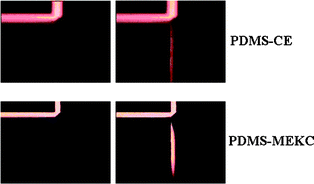High efficiency micellar electrokinetic chromatography of hydrophobic analytes on poly(dimethylsiloxane) microchips
Abstract
This paper describes a simple method for the effective and rapid separation of hydrophobic molecules on polydimethylsiloxane (PDMS) microfluidic devices using Micellar Electrokinetic Chromatography (MEKC). For these separations the addition of sodium dodecyl sulfate (SDS) served two critical roles – it provided a dynamic coating on the channel wall surfaces and formed a pseudo-stationary chromatographic phase. The SDS coating generated an EOF of 7.1 × 10−4 cm2 V−1 s−1 (1.6% relative standard deviation (RSD), n = 5), and eliminated the absorption of Rhodamine B into the bulk PDMS. High efficiency separations of Rhodamine B, TAMRA (6-carboxytetramethylrhodamine, succinimidyl ester) labeled amino acids (AA), BODIPY® FL CASE (N-(4,4-difluoro-5,7-dimethyl-4-bora-3a,4a-diaza-s-indacene-3-propionyl)cysteic acid, succinimidyl ester) labeled AA's, and AlexaFluor® 488 labeled Escherichia coli bacterial homogenates on PDMS chips were performed using this method. Separations of Rhodamine B and TAMRA labeled AA's using 25 mM SDS, 20% acetonitrile, and 10 mM sodium tetraborate generated efficiencies > 100 000 plates (N) or 3.3 × 106 N m−1 in <25 s with run-to-run migration time reproducibilities <1% RSD over 3 h. Microchips with 30 cm long serpentine separation channels were used to separate 17 BODIPY® FL CASE labeled AA's yielding efficiencies of up to 837 000 plates or 3.0 × 106 N m−1. Homogenates of E. coli yielded ∼30 resolved peaks with separation efficiencies of up to 600 000 plates or 2.4 × 106 N m−1 and run-to-run migration time reproducibilities of <1% RSD over 3 h.


 Please wait while we load your content...
Please wait while we load your content...